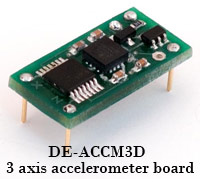|
A beginner’s guide to accelerometers
What is an accelerometer?
An accelerometer is an electromechanical device that will measure
acceleration forces. These forces may be static, like the constant
force of gravity pulling at your feet, or they could be dynamic -
caused by moving or vibrating the accelerometer.
What are accelerometers useful for?
By measuring the amount of static acceleration due to gravity, you can
find out the angle the device is tilted at with respect to the earth.
By sensing the amount of dynamic acceleration, you can analyze the way
the device is moving. At first, measuring tilt and acceleration doesn't seem all that
exciting. However, engineers have come up with many ways to make really
useful products with them.
An accelerometer can help your project understand its surroundings
better. Is it driving uphill? Is it going to fall over when it takes
another step? Is it flying horizontally or is it dive bombing your
professor? A good programmer can write code to answer all of these
questions using the data provided by an accelerometer. An accelerometer
can help analyze problems in a car engine using vibration testing, or
you could even use one to make a musical
instrument.
In the computing world, IBM and Apple have recently started using
accelerometers in their laptops to protect hard drives from damage. If
you accidentally drop the laptop, the accelerometer detects the sudden
freefall, and switches the hard drive off so the heads don't crash on
the platters. In a similar fashion, high g accelerometers are the
industry standard way of detecting car crashes and deploying airbags at
just the right time.

How do accelerometers work?
There are many different ways to make an accelerometer!
Some accelerometers use the piezoelectric effect - they contain
microscopic crystal structures that get stressed by accelerative
forces, which causes a voltage to be generated. Another way to do it is
by sensing changes in capacitance. If you have two microstructures next
to each other, they have a certain capacitance between them. If an
accelerative force moves one of the structures, then the capacitance
will change. Add some circuitry to convert from capacitance to voltage,
and you will get an accelerometer. There are even more methods,
including use of the piezoresistive effect, hot air bubbles, and light.
What things should I consider when buying an accelerometer?
Analog vs digital - First and
foremost, you must choose between an accelerometer with analog outputs
or digital outputs. This will be determined by the hardware that you
are interfacing the accelerometer with. Analog style accelerometers
output a continuous voltage that is proportional to acceleration. E.g.
2.5V for 0g, 2.6V for 0.5g, 2.7V for 1g. Digital accelerometers usually
use pulse width modulation (PWM) for their output. This means there
will be a square wave of a certain frequency, and the amount of time
the voltage is high will be proportional to the amount of acceleration.
If you are using a BASIC Stamp, or any other microcontroller with
purely digital inputs, you will most likely need to go for a digital
output accelerometer. The disadvantage here is that it requires you to
use the timing resources of the microcontroller to measure the duty
cycle, as well as performing a computationally intensive division
operation.
If you are using a PIC/AVR/OOPIC/Javelin with analog inputs, or a
completely analog based circuit, analog is almost always the best way
to go. Depending on the compiler, measuring analog acceleration can be
as simple as acceleration=read_adc(); and can be done in a few
microseconds.
Number of axes - For most projects, two is
enough. However, if you want to attempt 3d positioning, you will need a
3 axis accelerometer, or two 2 axis ones mounted at right angles.
Maximum swing - If you only care about measuring tilt using
earth's gravity, a ±1.5g accelerometer will be more than enough. If you
are going to use the accelerometer to measure the motion of a car,
plane or robot, ±2g should give you enough headroom to work with. For a
project that experiences very sudden starts or stops, you will need one
that can handle ±5g or more.
Sensitivity - Generally speaking, the more
sensitivity the better. This means that for a given change in
acceleration, there will be a larger change in signal. Since larger
signal changes are easier to measure, you will get more accurate
readings.
Bandwidth - This means the amount of times per
second you can take a reliable acceleration reading. For slow moving
tilt sensing applications, a bandwidth of 50Hz will probably suffice.
If you intend to do vibration measurement, or control a fast moving
machine, you will want a bandwidth of several hundred Hz.
Impedance/buffering issues - This is by far the
single most common source of problems in projects involving analog
accelerometers, because so few people thoroughly read the required
documentation. Both PIC and AVR datasheets specify that for A-D
conversion to work properly, the connected device must have an output
impedance under 10kΩ. Unfortunately, Analog Devices' analog
accelerometers have an output impedance of 32kΩ. The solution to this
is to use a low input offset rail to rail op amp as a buffer to lower
the output impedance. As far as we know, the DE-ACCM is the only
accelerometer solution that takes care of this problem for you.
Where can I find more information on accelerometers?
Texas Instruments has a great
accelerometer guide, including how to do some of the necessary math.
The DE-ACCM datasheet has several examples of
how you can use accelerometer readings to determine tilt and acceleration values.
If you really want to get into the hardcore low
level details of accelerometers, and want to try soldering surface mount
packages, Analog
Devices has a huge selection of datasheets covering both
analog and digital PWM style devices.
|


